 |
||
|
||
| ||
Multi-platform Budget Imitation of ZalmanIt didn't take Zalman Tech Co. long to gain prominence with its unusual high-quality products for cooling PC components. More importantly, it still leads among manufacturers of low-noise efficient coolers. So the laurels of this Korean company haunt many Taiwanese and Chinese startups. This seemingly simple success recipe of the South Asian company is not very easy to repeat though. We can often see young and unknown companies copy products and borrow ideas from the leaders in this industry. For example, various modifications of Zalman CNPS7000 that deluged the market several years ago - they came at more attractive prices than the original products, but their quality was not always adequate. Founded in 2004, Taiwanese CompTake Technology seems to take the same path. This company has recently launched Antazone air cooling systems — they were designed by a Taiwanese group of engineers, "innovators full of scientific and technological art of enthusiasm" (as their web site puts it). ;) This startup does not offer many products so far. But they cover almost all segments of air cooling systems for personal computers: coolers for CPUs, video cards, chipsets (motherboards), and hard drives.  The company organized epatage stands in 2006 at CeBIT and Computex to attract consumers to its products, 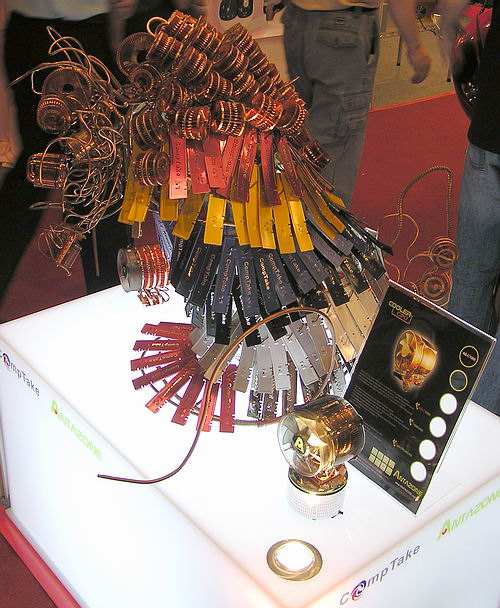 Antazone coolers at Computex.
where it illustrated advantages of its products of various classes and attracted partners from all over the world (including Russia). Although these products look good and are aggressively promoted by managers, who highlight originality of their products, an unbiased observer may have a deja vu: these products resemble the recent products from the famous company, mentioned in the subtitle and the first paragraph of this article. :) Let's find out how well the innovators from Antazone managed to "digest" foreign ideas and how good the budget counterparts of the CNPS9500 are.
Antazone AS-C1000 CPU CoolerWe are mostly interested in the model, which concept is the closest to Zalman CNPS9500 - the only (so far) processor cooler from Antazone — AS-C1000. 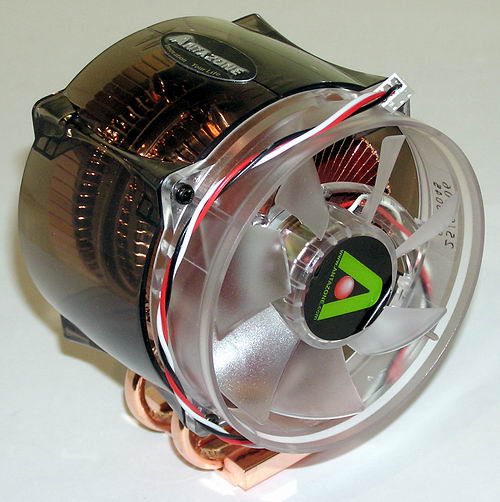 Judge for yourself: the copper base, polished like a mirror, and a cylindrical heatsink made of radial copper fins (0.3 mm thick) are connected with three curved 6 mm heat pipes. 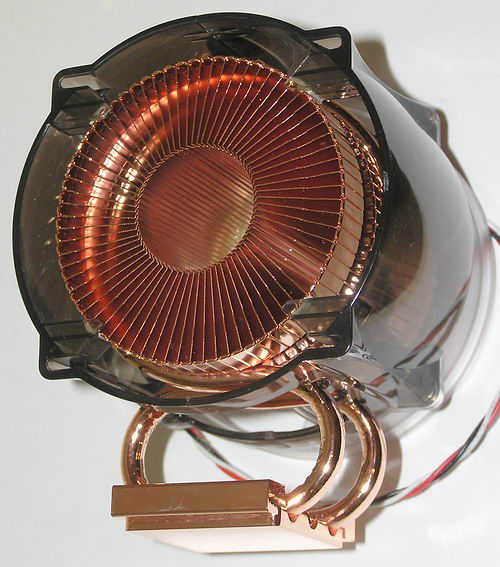 Its general concept is very much alike the heatsink of Zalman 9500, it's just smaller. That's why it's cheaper. The differences lie in concept implementation details (probably patented). Along with significantly smaller dimensions of the heatsink (80 mm outer diameter in Antazone versus 110 mm in CNPS 9500), the key differences consist in the following:
By the way, both models have practically the same fan diameters, because the AS - C 1000 uses a standard 3-pin 92 mm fan from Tek-Chain, A129525MH-F model with Magnetic Barometric bearing, up to 450 mA from 12V, 70000 hours MTBF, 2200 rpm, 25 dBA operating noise, up to 49.8 CFM airflow (2.61mm air pressure). Diameter of the AS-C1000 fan is a tad larger than the outer diameter of the heatsink, so the external transparent cylindrical plastic housing of the cooler (with company's logo) directs some of the airflow along the outside of the heatsink and heat pipes. This AS-C1000 design has a drawback - the inner part of the heatsink is closed to airflow (dead spot) and airflows from the cooler do not reach neighboring motherboard components (VRM of the processor is not cooled well). Besides, shorter heat pipes (S-shape instead of 8-shape) may have a negative effect on heat release. At the same time, the manufacturer promises that the thermal resistance of AS-C1000 will be 0.22C/W - very good (although almost twice as high as in Zalman CNPS9500 AT, see the table). Besides, we can only welcome the fact that the airflow from the fan is not wasted by going up and at the side of the heatsink (as it happens with the CNPS9500), but is forced through the cooler (presumably to the exhaust fan). Later on we'll analyze test results to see how efficient this approach is in practice. Table 1. Coolers' Specifications.
Cooler dimensions — 124 (height) × 101 (width) × 85 (length along the axis) - allow to install it on any motherboard in any orientation. The new product weighs 564 g (versus 530 g of the CNPS9500). The AS-C1000 is a multisocket cooler. It can be installed on all modern processors for LGA775, Socket AM2/939/940/754, and Socket 478. The cooler has a universal retention module, which consists of two extensible (rotatable) brackets, one of them (with soft insulators) being on the back side of the PCB, 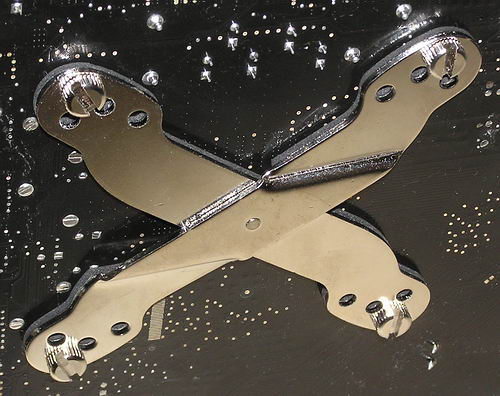 and four imposing screws for the counterframe to press the cooler to a processor. But this very frame may hamper installation of the cooler in some orientations.  It's rather difficult to install/remove the cooler, you are supposed to carefully balance the screws (and remove a motherboard from a PC case). The bundle includes four detailed illustrated installation manuals for four cases (K7, K8, LGA775 and Socket 478 processors). Besides, Antazone web site shows an animated flash clip that illustrates the installation process. The bundle also includes a mini-syringe with silvery thermal compound Antazone (25% of silver).  Its thermal conductivity exceeds 7.5 W/m-K, thermal resistance of this paste is below 0.06 C/W per square inch. The AS-C1000 comes in a stylish black box with a transparent window.
Antazone AS-D1000 and AS-V1000 Coolers for hard drives and video cardsThe company also offers passive and active solutions for cooling video cards and hard drives. Here are passive solutions (photos were taken at the stands of this company). 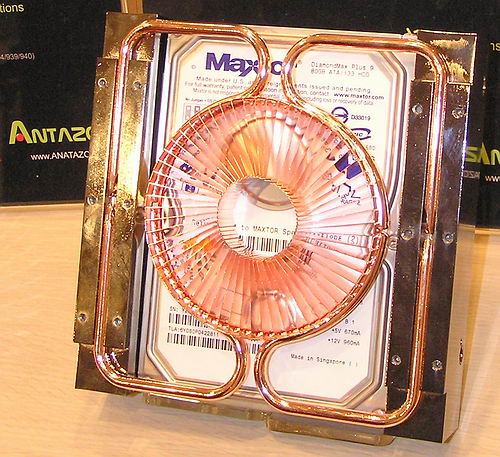 Noiseless Antazone AS-D1000 cooler for a hard drive.  Noiseless Antazone AS-V1000 cooler for a video card.
What concerns active solutions, they just add fans for better cooling. You can browse detailed characteristics of these products on the web sites of the manufacturer or engineers.
Chipset Coolers Antazone AS-N1000 and AS-N2000Along with passive and active coolers for video cards, hard drives and memory, Antazone also offers a couple of northbridge coolers. 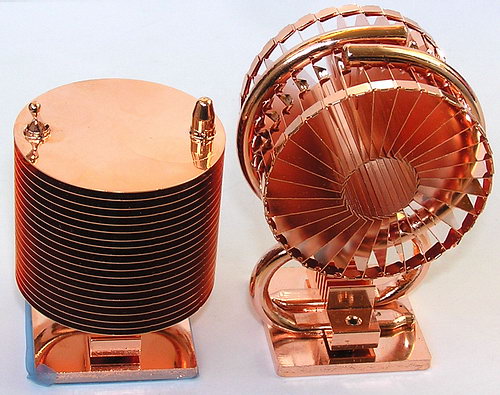 One of them is AS-N1000 . In fact, it's a miniature passive copy of the above mentioned AS-C1000. This "handsome" has a polished copper base (3-mm copper plate), connected to the cylindrical (50 mm in diameter) heatsink made of 0.3-mm copper fins with S-shaped 5-mm heat pipes. The pipes are soldered and pressed (with screws) into the base, as well as glued to the fin curves.  Dimensions of the cooler — 55×57×81 mm. The cooler is rather high. When installed on Northbridge, it may conflict with large CPU coolers. The passive cooler is absolutely noiseless. But some modern chipsets for Intel processors are quite voracious, so efficiency of their cooling with this heatsink will depend much on how actively (and in what direction) the nearby air circulates owing to system fans or a CPU cooler. Along with the universal retention module, the AS-N1000 comes with a square padding for an open chipset die (FC-PGA), 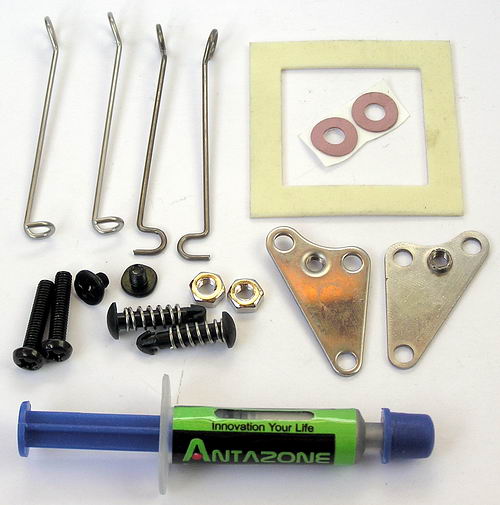 a tube of Antazone thermal compound (see above), as well as detailed illustrated installation instructions for four different sockets. Antazone and CompTech web sites show a flash movie about the installation process. Brief installation pictures are also published on the box. You'd better install this cooler with its axis vertical or parallel to the most intensive airflow. The cooler comes in a small stylish black box with a transparent window.  The second chipset cooler — Antazone AS-N2000 — is also a passive copper heatsink with a heat pipe.  The same 3-mm copper plate with a polished base and a soldered 5-mm heat pipe 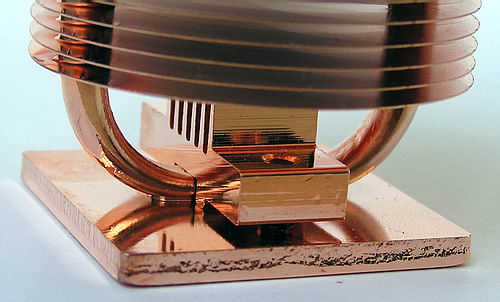 is cooled by a heatsink with 0.3-mm round copper fins. This cooler is smaller — 46×46×63 mm. It's absolutely quiet and its retention module (four types) is compatible with all motherboards (according to the manufacturer). The bundle is identical to that of the AS-N1000. This cooler is intended for cheaper solutions. We decided to skip heat release tests of passive chipset coolers, because the results will mostly depend on ventilation in a given computer and will hardly be illustrative. Heat release of the AS-C1000 CPU cooler was tested by our standard procedure.
Procedure for Evaluating Heat TransferAs always, we'll use a top dual-core processor Intel Core 2 Extreme X6800, operating at an increased frequency - 3.20 GHz (with the standard 1067 MHz FSB). It dissipates about 82 W in the typical operating mode (75 W*3.2 GHz/2.93 GHz). It will be used with coolers from some reviews written this year in autumn/winter. Heat release tests were performed on the Intel D975XBX motherboard, Intel 975X Express chipset, 1 GB of DDR2-667 memory, ASUS AX800 XT video card (ATI X800 XT). The motherboard was installed in a (closed) standard middle-ATX case PaloAlto PA-810 with the HiPro HP-W460GC31 PSU (460W), the quiet and "cold" WD800JD HDD, and one 90mm on the front panel to drive the air into the PC case at 2500rpm. Coolers were arranged to drive the air towards vent holes on the rear panel (we removed the fan there). Room temperature during our tests was kept at 22°C. Temperatures of the processor and motherboard (near the CPU voltage regulator) were read by built-in thermal sensors and Everest Ultimate Edition 3.01.652, SpeedFan 4.30 and Intel DCC under MS Windows XP SP2. We also registered the rotational speed of the CPU cooler. CPU was loaded by the Conroe-optimized S&M 1.8.1 on three different levels:
Of course, we also took readings of the idle system (0% load). EIST technology was enabled during our tests, because it corresponds to real situations. That's why the processor dropped its clock rate to 1.6 GHz when its was idle. This situation is illustrated by RMClock v 2.15. It was used to make sure there was no throttling in the course of our tests (we disabled the standard tools of activating throttling for the time of our tests). We tested Antazone AS-C1000 in two operating modes: powered by +12V and by +5V. Remember that Intel specs limit temperature of Core 2 Duo/Extreme to about 61°C. That is we are to find out how well the AS-C1000 copes with this task.
Results of Heat Release TestsLet's start with the hottest case under maximum (100%) CPU load in S&M. This load is usually generated by intensive computations in FPU processor units and rarely occurs in real life for a long time. Firstly, we must admit that Antazone AS-C1000 copes with cooling Intel Core 2 processor (overclocked to 3.2 GHz) to the standard temperatures (63°C — it's the temperature inside the die, which is usually several degrees higher than the temperature in the center of the heatspreader). That is our model under review can be used even with slightly overclocked Core 2 processors. Secondly, its heat release is better than in a boxed cooler, but not much better. However, their prices differ significantly. ;) Thirdly, it's significantly outperformed by its prototype (Zalman CNPS9500) in heat release at the same fan speed. Moreover, it's outperformed by many other modern coolers with heat pipes. Although its defeat to such advanced large and expensive coolers as Cooler Master Mars and Hyper UC is not that significant (moreover, when powered from +5V, the AS-C1000 cools even better than the latter models). That is on the whole, the AS-C1000 is quite an efficient solution, despite its small size and design flaws. However, it does not cool a motherboard as much as we'd like it to (see design flaws above). If we proceed to a more realistic CPU load (75% according to S&M, Diagram Two, or simple office/multimedia load - 50% according to S&M, Diagram Three), the AS-C1000 will preserve the above heat release tendency. That is it's slightly outperformed by most more expensive and bigger coolers with heat pipes (and it's heavily outperformed by such leaders as Zalman 9x00 and Thermaltake Big Typhoon). But it copes with its task well at full speed. When its fan speed is reduced (powered from 5V), it performs even better than some heatpiped Cooler Masters. It even manages to cool our "complicated" processor to the normal level under 50% computational load. When CPU is idle, Antazone AS-C1000 has no problems with cooling even at reduced rotational speed, although it does not ventilate motherboard components well.
Acoustic testsWe measured the noise generated by coolers using the VSV-003-M3 sound level meter according to our test procedure. We measured the level of sound pressure at a distance equivalent to one meter (according to our State Standard), weighted by the A spectral curve. According to this device, the background level of a quiet room is 20.5 dBA. We measured the sound level (pressure) in a diffuse field at 25 cm from a fan. The results were recalculated to the 1 m distance by subtracting 12 dB. These results are almost no different from the specification values at the lowest noise levels (the most critical to measurement error). Maximum noise results of some coolers match our previous noise readings of the same coolers made by the other test procedure. So we can draw a conclusion that our approach to measuring cooler noise is correct and provides real numbers. Our noise readings are published on the diagram together with fan's tachometer readings. This model is not very loud at full speed compared to many similar products: 40 dBA — it's not much higher than in Zalman CNPS9500 at full speed and is even lower than in Cooler Master Mars, Hyper UC, Eclipse and GlacialTech 5700 MC (with similar fan speed). However, there was one problem. The fan in our AS-C1000 sample was audibly creaking, so its noise level was higher by 1 dBA at full speed and by 3 dBA at low speed than on the diagram. Fortunately, we had an identical fan in our lab (model and speed), which generated much less noise. So we used it to replace the defective fan in the cooler. After that, the AS-C1000 became much quieter — especially at reduced speed, when its average noise level was just 23 dBA. That's similar to Zalman CNPS9700 LED at the lowest speed possible (reduced with FanMate 2). It's evidently better than in the above mentioned models as well as in Thermaltake Big Typhoon VX at 1300 rpm. So, this noise level is hardly audible on the background of a hard drive and a slow PSU fan.
PricePrices for the new products vary from $35 for the AS-C1000 and about $20 for chipset coolers. They are a tad too high, in our opinion, considering the test results.
ConclusionPrototypes of air coolers for key PC components from a young Taiwanese group (Antazone) offer some original design ideas and visual attractiveness, although they still evidently copy the market leaders. Small dimensions, all-copper design, a good retention module, universality, and relatively low prices (it depends) can attract customers. Especially as the AS-C1000 CPU cooler is no worse in technical characteristics (heat release, noise), or even better than some more expensive famous counterparts. It copes well with cooling top Intel Conroe processors. At the same time, these coolers have some drawbacks. For example, Antazone AS-C1000 is not the most efficient and quiet model in its price segment (Thermaltake Big Typhoon and Cooler Master Hyper TX are much more attractive, though they are larger). AS-N1000 and AS-N2000 coolers for chipsets are probably rather expensive (besides, many manufacturers of expensive motherboards (target models for such coolers) equip them with passive coolers with heat pipes). Besides, the standard boxed cooler from Sanyo-Denki (with a copper core) is not much worse in cooling terms than the AS-C1000. It can replace it in many cases. What concerns overclockers and enthusiasts, they will most likely prefer other solutions to AS-C1000. So, the retail-fate of attractive Antazone products will depend on many factors, but mostly on their prices compared to competing products. However, the company has already demonstrated the improved AS-C2000 CPU cooler with a larger heatsink and four heat pipes instead of three (it's not available on the official web site yet). It seems to possess better heat release characteristics.  Its fanless modification (AS-C2100) was used in a truly original superquiet computer with fanless coolers for the chipset and video card (see the photo). 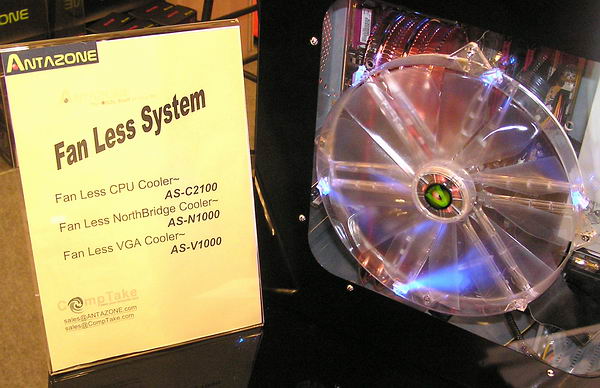  So, if you love shiny all-copper original quiet coolers, you may consider these products. ;)
Write a comment below. No registration needed!
|
Platform · Video · Multimedia · Mobile · Other || About us & Privacy policy · Twitter · Facebook Copyright © Byrds Research & Publishing, Ltd., 1997–2011. All rights reserved. | ||||||||||||||||||||||||||||||||||||||||||||||||||||||||||||||||||||||||||||||||||||||||||||||||||||||||